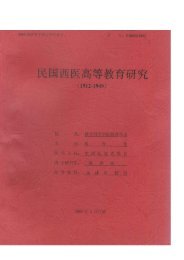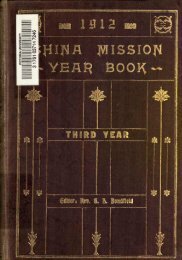- Page 2 and 3:
\ STUDIA INPresented toTHE LIBRARYo
- Page 5 and 6:
THECHINA MISSIONYEAR BOOK1916(SEVEN
- Page 8 and 9:
Chine"IVimportant it may be, b
- Page 10 and 11:
CONTENTSPREFACECONTENTSCONTRIBUTORS
- Page 12 and 13:
VI 11CONTENTSChapterPAGEFriend s Fo
- Page 14 and 15:
CONTENTSChapterPART VII.INTERDENOMI
- Page 16 and 17:
CONTRIBUTORS"(The figure in pa
- Page 18 and 19:
XIVCONTRIBUTORSRev. J. A, O. Gotttb
- Page 20 and 21:
LONDONXVICONTRIBUTORSRev. Charles E
- Page 23 and 24:
"PARTGENERAL REVIEW OF THE YEA
- Page 25 and 26:
"TWO DECADES OF CHANGES IN CHI
- Page 27 and 28:
"""TWO DECADES OF CH
- Page 29 and 30:
TWO DECADES OF CHANGES IN CHINA 7Un
- Page 31 and 32:
TWO DECADES OF CHANGES IN CHINA 9Th
- Page 33 and 34:
CHAPTER IIEFFECT OF THE WAR ON MISS
- Page 35 and 36:
EFFECT OF THE WAR ON MISSIONS IN CH
- Page 37 and 38:
EFFECT OF THE WAR ON MISSIONS IN CH
- Page 39 and 40:
EFFECT OF THE WAR ON -MISSIONS IN C
- Page 41 and 42:
EFFECT OF THE WAR ON MISSIONS IN CH
- Page 43 and 44:
EFFECT OF THE WAR ON MISSIONS IN CH
- Page 45 and 46:
CONSTITUTIONAL DEVELOPMENT, 1915 23
- Page 47 and 48:
It" we""CONSTITUTION
- Page 49 and 50:
"". ItHieCONSTITUTIONAL D
- Page 51 and 52:
CONSTITUTIONAL DEVELOPMENT, 1915 29
- Page 53 and 54:
.Vif>lCONSTITUTIONAL DEVELOP
- Page 55 and 56:
""CONSTITUTIONAL DEVELOPM
- Page 57 and 58:
CHAPTERIVECONOMIC AND COMMERCIAL CO
- Page 59 and 60:
ECONOMIC AND COMMERCIAL CONDITIONS
- Page 61 and 62:
ECONOMIC AND COMMERCIAL CONDITIONS
- Page 63 and 64:
virtueECONOMIC AND COMMERCIAL CONDI
- Page 65 and 66:
AND COIMiAIKlU IAL CONDITIONS IN CH
- Page 67 and 68:
ANGLICAN GROUP 45Chekiang, Fukien,
- Page 69 and 70:
ANGLICAN CROUP 47The chief institut
- Page 71 and 72:
ii<lANGLICAN GROUP 4-9The wo
- Page 73 and 74:
( Americant 1845ANGLICAN GROUP 51DO
- Page 75 and 76:
ANGLICAN GROUP 03persons from 1,251
- Page 77 and 78:
"( ChurchEmployed<&
- Page 79 and 80:
ANGLICAN GROUP 57this station may b
- Page 81 and 82:
eginSynodANGLICAN GROUP 59Now if th
- Page 83 and 84:
ChristiansANGLICAN GROUP 01The prin
- Page 85 and 86:
(),."")_<)(]91o)CH
- Page 87 and 88:
BAPTIST GROUP 05where union movemen
- Page 89 and 90:
,AlongBAPTIST GROUP 67limit the wor
- Page 91 and 92:
TTJtheBAPTIST GKOITP 60BAPTIST MISS
- Page 93 and 94:
General"BAPTIST GROUP 71buildi
- Page 95 and 96:
BAPTIST (ihundred and has proved ve
- Page 97 and 98:
BAPTIST GROUPK>That men of b
- Page 99 and 100:
"CONGREGATIONAL GROUP 77grades
- Page 101 and 102:
CONGREGATIONAL GROUP 79p f<T
- Page 103 and 104:
CONGREGATIONAL GROUP 81^ r *Handboo
- Page 105 and 106:
KmployedCHAPTERLUTHERANVIIIGROUPEVA
- Page 107 and 108:
LUTHERAN GROUP 85To realize this pr
- Page 109 and 110:
"LUTHERAN GROUP 87There has be
- Page 111 and 112:
"LUTHERAN GROUP 89The missiona
- Page 113 and 114:
LUTHERAN GROUP 91people, and also o
- Page 115 and 116:
LUTHERAN GROUP 93China until the fi
- Page 117 and 118:
LUTHERAN GROUP 95and partly because
- Page 119 and 120:
LUTHERAN GROUP 97been held simultan
- Page 121 and 122:
,InLUTHERAN GROUP 99seven hundred a
- Page 123 and 124:
.LUTHERAN UROUP 101aiiy longer. In
- Page 125 and 126:
LUTHERAN GROUP 103studies are sent
- Page 127 and 128:
METHODIST GKOtjP 105number their co
- Page 129 and 130:
METHODIST GftOUPOM cf 1 WfcMedical
- Page 131 and 132:
METHODIST GROUP 109Church sustains
- Page 133 and 134:
""""METHODIST G
- Page 135 and 136:
METHODIST GROUP 113A large amount o
- Page 137 and 138:
METHODIST GROUP 115Theology for a f
- Page 139 and 140:
METHODIST GROUP 117preachers and 14
- Page 141 and 142:
METHODIST GROUP 119The recent death
- Page 143 and 144:
METHODIST GROUP 121Committee recogn
- Page 145 and 146:
"PRESBYTERIAN GROUP 123God to
- Page 147 and 148:
occupation:PRESBYTERIAN GROUP 125Mi
- Page 149 and 150:
PRESBYTERIAN GROUP 127of College gr
- Page 151 and 152:
PRESBYTERIAN GROUP 129probably to c
- Page 153 and 154:
"PRESBYTERIAN GROUP 131The spi
- Page 155 and 156:
PRESBYTERIAN GROUP 133throughout th
- Page 157 and 158:
""PRESBYTERIAN GROUP 135R
- Page 159 and 160:
"PRESBYTERIAN GROUP 137ten yea
- Page 161 and 162:
~,PRESBYTEK1AN (JKOUP 139to raise t
- Page 163 and 164:
PRESBYTERIAN GROUP 141of eight Chin
- Page 165 and 166:
.""PRESBYTERIAN GROUP 143
- Page 167 and 168:
OTHER MISSIONS AND ASSOCIATIONS 145
- Page 169 and 170:
OTHER MISSIONS AND ASSOCIATIONS 147
- Page 171 and 172:
OTHER MISSIONS AND ASSOCIATIONS 149
- Page 173 and 174:
OTHER MISSIONS AND ASSOCIATIONS 151
- Page 175 and 176:
"OTHER MISSIONS AND ASSOCIATIO
- Page 177 and 178:
OTHER MISSIONS AND ASSOCIATIONS 155
- Page 179 and 180:
. TheOTHER MISSIONS AND ASSOCIATION
- Page 181 and 182:
OTHER MISSIONS AND ASSOCIATIONS 159
- Page 183 and 184:
OTHER MISSIONS AND ASSOCIATIONS 161
- Page 185 and 186:
OTHER MISSIONS AND ASSOCIATIONS 163
- Page 187 and 188:
OTHER MISSIONS AND ASSOCIATIONS 165
- Page 189 and 190:
OTHER MISSIONS AND ASSOCIATIONS 167
- Page 191 and 192:
OTHER MISSIONS AND ASSOCIATIONS 169
- Page 193 and 194:
totalOTHER MISSIONS AND ASSOCIATION
- Page 195 and 196:
OTHER MISSIONS AND ASSOCIATIONS 173
- Page 197 and 198:
RESOLUTIONS AND FINDINGS 175The par
- Page 199 and 200:
RESOLUTIONS AND FINDINGS 177women,
- Page 201 and 202:
RESOLUTIONS AND FINDINGS 179will al
- Page 203 and 204:
RESOLUTIONS AND FINDINGS 181work. T
- Page 205 and 206:
RESOLUTIONS AND FINDINGS 183meet th
- Page 207 and 208:
RESOLUTIONS AND FINDINGS 185II.REPO
- Page 209 and 210:
""WhyRESOLUTIONS AND FIND
- Page 211 and 212:
""RESOLUTIONS AND FINDING
- Page 213 and 214:
RESOLUTIONS AND FINDINGS 1916. That
- Page 215 and 216:
EVANGELISM IN COUNTRY DISTRICTS 193
- Page 217 and 218:
EVANGELISM IN COUNTRY DIRTRICTS 195
- Page 219 and 220:
EVANGELISM IN THE COUNTRY DISTRICTS
- Page 221 and 222:
EVANGELISM IN THE COUNTRY DISTRICTS
- Page 223 and 224:
"<jEVANGELISM IN THE CO
- Page 225 and 226:
""EVANGELISM IN THE COUNT
- Page 227 and 228:
EVANGELISM IN THE COUNTRY DISTRICTS
- Page 229 and 230:
EVANGELISM IN THE COUNTRY DISTRICTS
- Page 231 and 232:
EVANGELISM IN THE COUNTRY DISTRICTS
- Page 233 and 234:
.<EVANGELISM IN THE COUNTRY
- Page 235 and 236:
EVANGELISM IN THE COUNTRY DISTRICTS
- Page 237 and 238:
NeedlessEVANGELISM IN THE COUNTRY D
- Page 239 and 240:
EVANGELISM IN THE COUNTRY DISTRICTS
- Page 241 and 242:
EVANGELISM IN THE COUNTRY DISTRICTS
- Page 243 and 244:
""EVANGELISM 221was imper
- Page 245 and 246:
EVANGELISM IN THE COUNTRY DISTRICTS
- Page 247 and 248:
EVANGELISM IN THE COUNTRY DISTRICTS
- Page 249 and 250:
^- nEVANGELISM AMONG STUDENTS 227th
- Page 251 and 252:
EVANGELISM AMONG STUDENTS 229doors
- Page 253 and 254:
EVANGELISM AMONG STUDENTS 231Mr. (J
- Page 255 and 256:
EVANGELISM AMONG STUDENTS 233* wjr
- Page 257 and 258:
EVANGELISM AMONG STUDENTS2o;)consis
- Page 259 and 260:
EVANGELISM AMONG STUDENTS 237"
- Page 261 and 262:
EVANGELISM AMONG STUDENTSThe moveme
- Page 263 and 264:
"EVANGELISM AMONG STUDENTS 241
- Page 265 and 266:
EVANGELISM AMONG STUDENTS 243(4) Sp
- Page 267 and 268:
""""DEVELOPMENT
- Page 269 and 270:
DEVELOPMENTS IN PROVINCES AND CITIE
- Page 271 and 272:
EVANGELISM IN PROVINCES AND CITIES
- Page 273 and 274:
PrintedDEVELOPMENTS IN PROVINCES AN
- Page 275 and 276:
PART IVGENERAL AND RELIGIOUS EDUCAT
- Page 277 and 278:
CollegeMISSIONARY EDUCATIONAL WORK
- Page 279 and 280:
MISSIONARY EDUCATIONAL WORK 257Educ
- Page 281 and 282:
MISSIONARY EDUCATIONAL WORK 259Anot
- Page 283 and 284:
MISSIONARY EDUCATIONAL WORK 261unde
- Page 285 and 286:
PRESENT STATUS OF GOVERNMENT EDUCAT
- Page 287 and 288:
PRESENT STATUS OF GOVERNMENT EDUCAT
- Page 289 and 290:
PRESENT STATUS OF GOVERNMENT EDUCAT
- Page 291 and 292:
>CHINA CHRISTIAN EDUCATIONAL
- Page 293 and 294:
"CHINA CHRISTIAN EDUCATIONAL A
- Page 295 and 296:
CHAPTER XIXTHE COMPARATIVE LAW SCHO
- Page 297 and 298:
CHINA CHRISTIAN EDUCATIONAL ASSOCIA
- Page 299 and 300:
"INDUSTRIAL EDUCATION IN MISSI
- Page 301 and 302:
INDUSTRIAL EDUCATION IN MISSION SCH
- Page 303 and 304:
. ~iNDtfSTltlAL EDUCATION IN MISSIO
- Page 305 and 306:
""^INDUSTRIAL EDUCATION I
- Page 307 and 308:
CHAPTER XXITRADE SCHOOL OF THEYOUNG
- Page 309 and 310:
TRADE SCHOOL 287It will perhaps bo
- Page 311 and 312:
CHAPTERXXIIEXTRACTS FROM THE REPORT
- Page 313 and 314:
REPORT OP THE COMMITTEE ON MIDDLE S
- Page 315 and 316:
REPORT OF THE COMMITTEE ON MIDDLE S
- Page 317 and 318:
REPORT OF THE COMMITTEE ON MIDDLE S
- Page 319 and 320:
REPORT OF THE COMMITTEE ON MIDDLE S
- Page 321 and 322:
BOYS EDUCATION IN PUKIEN 290The las
- Page 323 and 324:
>//mission;>,<
- Page 325 and 326:
CHAPTER XXIVTHE CHINA SUNDAY SCHOOL
- Page 327 and 328:
"CHINA SUNDAY SCHOOL UNION 305
- Page 329 and 330:
.".P.iblc</<CHIN
- Page 331 and 332:
"CHAPTERXXVTHE BIBLE SCHOOL CO
- Page 333 and 334:
PARTMEDICAL AND PHILANTHROPIC WORKV
- Page 335 and 336:
BEVIKNV OF MEDICAL MISSIONARY WORKj
- Page 337 and 338:
REVIEW OF MEDICAL MISSIONARY WORK o
- Page 339 and 340:
"""CHAPTERXXVIITHE N
- Page 341 and 342:
theTPIE NATIONAL MEDICAL ASSOCIATIO
- Page 343 and 344:
THE CHINA MEDICAL BOARD 321^ lie ^e
- Page 345 and 346:
THE CHINA MEDICAL BOARD 323China an
- Page 347 and 348:
DEVELOPMENT AT HUNAN-YALE COLLEGE O
- Page 349 and 350:
"""MEN AND WOMEN NUR
- Page 351 and 352:
"""MEN AND WOMEN NUR
- Page 353 and 354:
COUNCIL ON PUBLIC HEALTHool3. That
- Page 355 and 356:
COUNCIL ON PUBLIC HEALTH 333as Tube
- Page 357 and 358:
THE CHURCH IN CHINESE CHRISTIAN PER
- Page 359 and 360:
THE CHURCH IN CHINESE CHRISTIAN PER
- Page 361 and 362:
THE CHURCH IN CHINESE CHRISTIAN PER
- Page 363 and 364:
THE CHURCH IN CHINESE CHRISTIAN PER
- Page 365 and 366:
THE CHUltCll IN CHINESE ClJUJSTIAN
- Page 367 and 368:
""THE CHURCH IN CHINESE C
- Page 369 and 370:
ft" 4P>yl>yR.P&a
- Page 371 and 372:
THE CHURCH IN CHINESE CHRISTIAN PER
- Page 373 and 374:
THE CHURCH IN CHINESE CHRISTIAN PER
- Page 375 and 376:
THE CHURCH IN CHINESE CHRISTIAN PER
- Page 377 and 378:
CHAPTER XXXIIIPRESENT-DAY PROBLEMS
- Page 379 and 380:
PRESENT DAY PROBLEMS 357There is la
- Page 381 and 382:
PRESENT DAY PROBLEMS 359sermons, to
- Page 383 and 384:
CHAPTER XXXIVFINDINGS REGARDING CHI
- Page 385 and 386:
CHINESE EVANGELISTIC LITERATURE 363
- Page 387 and 388:
If"#"BEST SELLING BOOKS 3
- Page 389 and 390:
Wi&"BEST SELLING BOOKS 367Trac
- Page 391 and 392:
BEST SELLING BOOKS 369Po alar Books
- Page 393 and 394:
CHAPTER XXXVIBIBLE AND TRACT SOCIET
- Page 395 and 396:
BIBLE AND T1IACT SOCIETIES 373The B
- Page 397 and 398:
BIBLE AND TRACT SOCIETIES 375showin
- Page 399 and 400:
PARTVIIOTHER INTERDENOMINATIONALASS
- Page 401 and 402:
atasbeenTHE CHINA CONTINUATION COMM
- Page 403 and 404:
FeetTHE CHINA CONTINUATION COMMITTE
- Page 405 and 406:
THE CHINA CONTINUATION COMMITTEE 38
- Page 407 and 408:
THE CHINA CONTINUATION COMMITTEE 38
- Page 409 and 410:
"THE CHINA CONTINUATION COMMIT
- Page 411 and 412:
THE CHINA CONTINUATION COMMITTEE 08
- Page 413 and 414:
"THE CHINA CONTINUATION COMMIT
- Page 415 and 416:
Ichang,THE CHINA CONTINUATION COMMI
- Page 417 and 418:
THE CHINA CONTINUATION COMMITTEE 39
- Page 419 and 420:
THE CHINA CONTINUATION COMMITTEE )9
- Page 421 and 422:
THE CHINA CONTINUATION COMMITTEE 39
- Page 423 and 424:
CHAPTER XXXVIIIUNION MOVEMENTS AMON
- Page 425 and 426:
"UNION MOVEMENTS AMONG METHODI
- Page 427 and 428:
UNION MOVEMENTS AMONG METHODISTS IN
- Page 429 and 430:
CHAPTER XXXIXA YEAR S PROGRESS INTH
- Page 431 and 432:
TRAINING OF MISSIONARIES 4:09Confer
- Page 433 and 434:
.""TRAINING OF MISSIONARI
- Page 435 and 436:
413with a common problem, on the pa
- Page 437 and 438:
""CHILDREN 415is also a w
- Page 439 and 440:
SCHOOLS FOR MISSIONARIES 5 CHILDREN
- Page 441 and 442:
SCHOOLS FOR MISSIONARIES CHILDREN 4
- Page 443 and 444:
SCHOOLS FOR MISSIONARIES CHILDREN 4
- Page 445 and 446: STUDENT VOLUNTEER MOVEMENT 423the C
- Page 447 and 448: ""UNITED SOCIETY OF CHRIS
- Page 449 and 450: TRAINING SCHOOLS FOR MISSIONARIES 4
- Page 451 and 452: TRAINING SCHOOLS FOR MISSIONARIES 4
- Page 453 and 454: TRAINING SCHOOLS FOR MISSIONARIES 4
- Page 455 and 456: <{PROVINCIAL SURVEYS 4332. T
- Page 457 and 458: PROVINCIAL SURVEYS 435on the maps t
- Page 459 and 460: PROVINCIAL SURVEYS 437II.A SURVEY O
- Page 461 and 462: PROVINCIAL SURVEYS 439Missionaries
- Page 463 and 464: PROVINCIAL SURVEYS 441and private h
- Page 465 and 466: PROVINCIAL SURVEYS 443Chinese Chris
- Page 467 and 468: PROVINCIAL SURVEYS 445These central
- Page 469 and 470: "PROVINCIAL SURVEYS 447while t
- Page 471 and 472: PROVINCIAL SURVEYS 449That the Miss
- Page 473 and 474: CITY SURVEYS 451It required in many
- Page 475 and 476: CITY SURVEYS 453ill attendance. Rec
- Page 477 and 478: CITY SURVEYS 455work of the mission
- Page 479 and 480: CITY SURVEYS 4577. There is the fai
- Page 481 and 482: CITY SURVEYS 459been thai its needs
- Page 483 and 484: , ,<CITY SURVEYS 461resident
- Page 485 and 486: "CITY SURVEYS 403The populatio
- Page 487 and 488: CITY SURVEYS 465to do this, would w
- Page 489 and 490: CITY SURVEYS 467per cent (85%) repo
- Page 491 and 492: "CITY SURVEYS 469Two years ago
- Page 493 and 494: (JIT if SURVEYS 471Cliieliow, which
- Page 495: CITY SURVEYS 473appointed days. Dur
- Page 499 and 500: ;Th<>SOCIAL AND INDUS
- Page 501 and 502: "",SOCIAL AND INDUSTRIAL
- Page 503 and 504: ""whichSOCIAL AND INDUSTR
- Page 505 and 506: ,".,X<>00SOCIAL
- Page 507 and 508: 1:;<>.<)SOCIAL
- Page 509 and 510: 824SOCIAL AND INDUSTRIAL CONDITIONS
- Page 511 and 512: "OTHER MOVEMENTS FOR SOCIAL BE
- Page 513 and 514: OTHER MOVEMENTS FOR SOCIAL BETTERME
- Page 515 and 516: "OTHER MOVEMENTS FOR SOCIAL BE
- Page 517 and 518: OTHER MOVEMENTS FOR SOCIAL BETTERME
- Page 519 and 520: OBITUARIES 497Covert, Miss Martha C
- Page 521 and 522: OBITUARIES 499Snodgrass, Miss Mary.
- Page 523 and 524: ;>. IfTREATIES METWEEN CHINA
- Page 525 and 526: TREATIES BETWEEN CHINA AND JAPAN 50
- Page 527 and 528: APPENDIXTHE DEfi^AND OF THE JAPANES
- Page 529 and 530: </vvr/Vr.Uifinterimnnm&g
- Page 531 and 532: (<)(7>)HowThethreeser
- Page 533 and 534: "CONSTITUTIONS AND AGREEMENTS~
- Page 535 and 536: ",>. ThatCONSTITUTION*
- Page 537 and 538: 19l-">.CONSTITUTIONS AN
- Page 539 and 540: electedI).CONSTITUTIONS OF UNION IN
- Page 541 and 542: CONSTITUTIONS OF UNION INSTITUTIONS
- Page 543 and 544: : .SectionS< rHnnTheVote,CON
- Page 545 and 546: .../"."CONSTITUTIONS OF U
- Page 547 and 548:
.".. NoT<> x/vwt
- Page 549 and 550:
OTHER CONSTITUTIONS AND AGREEMENTS
- Page 551 and 552:
OTHER CONSTITUTIONS AND AGREEMENTS
- Page 553 and 554:
APPENDICES 531- r^ o c-l :? y; ci v
- Page 555 and 556:
"PARTXISTATISTICS AND CHARTSC.
- Page 557 and 558:
STATISTICS AND CHARTS 535schedules
- Page 559 and 560:
fcTATiSTlCS AND CHARTS 537that the
- Page 561 and 562:
QuinsanDIARY OF PRINCIPAL EVENTSIn
- Page 563:
DIARY OF PRINCIPAL EVENTS 541J9J6Ja
- Page 566 and 567:
INDEXCanon of the Board of Missions
- Page 568 and 569:
546 INDEXschool principals, 263; of
- Page 570 and 571:
548 INDEXties. 47, 77, 90, 93, Oli.
- Page 572 and 573:
550 INDEXMinistry of Education, 264
- Page 574 and 575:
INDEXSalvation Fund, 352.Sain a, O.
- Page 576:
554 INDEXchange in China, 36-7; oni










